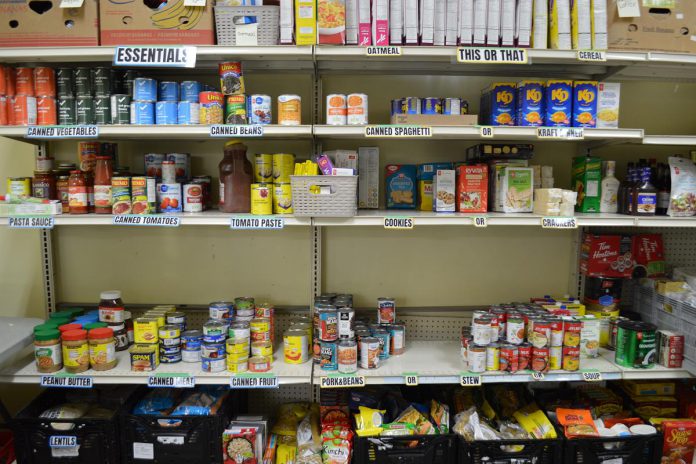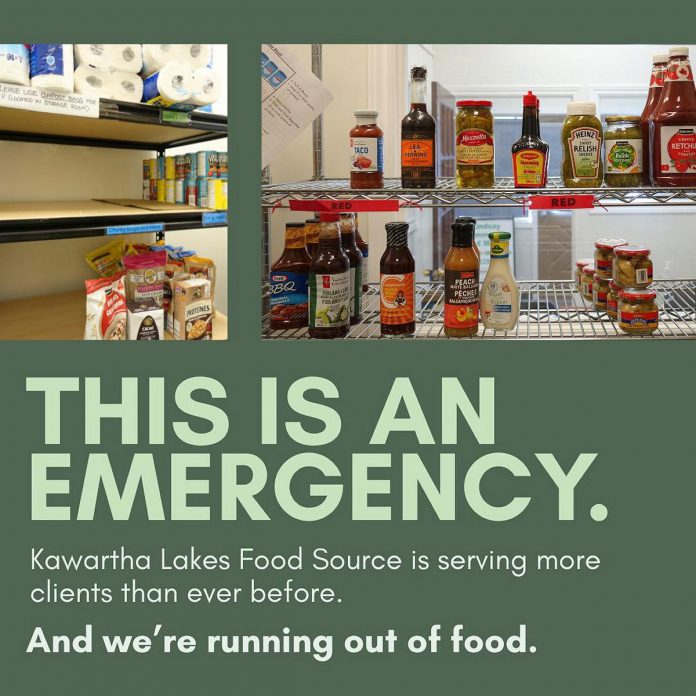
On the heels of Food Banks Canada reporting the highest-ever number of monthly food bank visits and signs the food bank system is buckling under the strain, Kawartha Lakes Food Source (KLFS) says it has found itself in situations this year of having “alarmingly low inventory” on hand.
As the provider to member food banks in the City of Kawartha Lakes, in the summer KLFS issued a state of emergency plea to the community for assistance stocking its shelves.
Local food bank usage is up and donations are down, said KLFS donor stewardship coordinator Erika Henry, reflecting the findings of Food Banks Canada’s “HungerCount 2024” report released on Monday (October 28).
Some of the national report’s overall findings include the fact that in March 2024, there were more than two million visits to food banks in Canada — the highest number in history. The number of visits represent a six per cent increase compared to 2023, and a 90 per cent increase compared to 2019. At the same time, “there are signs that the food-banking system is reaching its absolute limit,” the report states.
Henry told kawarthaNOW “the report definitely reflects our situation locally.”
“While our inventory has begun to see the typical holiday season boost, we are still concerned about what happens after the giving boom,” said Henry. “Late winter can be particularly challenging as the inventory starts to wane again while demand increases due to lack of seasonal employment, increased heating costs, and lack of locally available fresh food.”
“Regarding the report’s claim that 30 per cent of food banks are running out of food, we have had moments this year of alarmingly low inventory and at times have had to reduce what was being sent out to our member food banks, with some getting as little as half of what we would typically supply,” she added.

Following KLFS’s social media post in late July declaring the state of emergency, the community responded by donating more than 2,000 pounds of food in the weeks that followed.
“We love this community and are so appreciative of the generous support we receive, but it is unfortunately a band-aid solution that doesn’t address the issues of poverty and a broken social safety net that Food Banks Canada highlights in the report,” Henry said.
The HungerReport notes the two million visits in March “is consistent with record high rates of food insecurity and reflects findings from other recent studies showing greater numbers of people experiencing economic hardship.”
“This year’s increase is happening against the backdrop of the ongoing affordability crisis and an uptick in unemployment rates, including a significant increase in unemployment rates among recent newcomers than in previous years,” the report states.
According to the HungerCount report, 18 per cent of food bank clients now report employment as their main source of income, compared to 16.7 per cent in 2023 and 12 per cent in 2019.
“The fact that having a job no longer protects people from facing food insecurity means that more members of the community are needing our services while fewer are able to support us,” Henry said.
The report adds the number of food bank clients who report employment as their main source of income has historically been between 10 and 12 per cent, but began to climb in 2022 along with the rapid increase in inflation.
“This year, the cumulative impact of inflation has further eroded the purchasing power of people in employment, including many whose incomes are above the official poverty line,” the report states.
Meanwhile, the majority of food bank clients continue to report “grossly inadequate provincial social assistance” as their source of income.
Like Food Banks Canada, KLFS says food banks are not a solution for ending hunger in Canada.
“We are aligned with Food Banks Canada’s position that food insecurity is an income issue, and food banks are not the answer,” Henry said. “We provide emergency food and supplies to those in need, but with demand increasing this dramatically after over 22 years in operation, it’s safe to say that we are well beyond an emergency.”
In 2023, KLFS recorded 13,670 visits to its member food banks and is averaging 1,127 monthly visits this year.
KLFS operates from a centralized distribution centre, where it collects food from reclamation sources, buys food in bulk, sorts, and stores food, promotes awareness of hunger and its impact, and co-ordinates fundraising. It provides food and personal care items to its member organizations on a monthly, fair share basis. The organization supports eight food banks, six social service agencies, and 21 student breakfast programs.
“A food bank is not meant to be a permanent fixture in anyone’s life,” Henry pointed out. “We fully support Food Banks Canada’s recommendations for long-term government action needed to address affordability issues and fix Canada’s broken social safety net.”
To read Food Banks Canada’s 2024 HunterCount report, visit foodbankscanada.ca/hungercount.


























